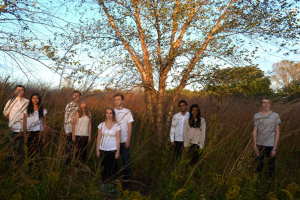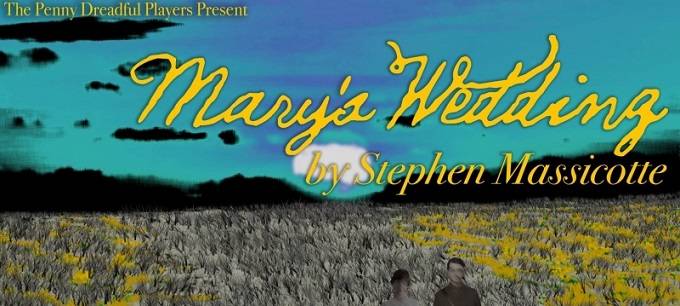Modern theatre often leaves quite a bit of room for interpretation, ensuring re-view-ability by requiring more input from the director and production team, producing unique results for each staging. Such is the case with Mary’s Wedding, a 2002 play by Stephen Massicotte. Placing a classic lovers-torn-asunder-by-war story primarily within dreams, there are no limits on how each particular imagination could choose to present this play.
Penny Dreadful Players (PDP), University of Illinois’ original theatre company, chose this play for the fall season around the same time the Station Theatre was previewing their run. That was a beautiful and traditional presentation, with two cast members (Mary and Charlie) and a couple surprises along the way. When Stephanie Svarz, student director for PDP, told me her run was about to begin, I knew from her initial email that this production was going to be very different.
 “I’d be happy to tell you a little bit more about our production and some of the unique ways we’ve gone about the ensemble-based rehearsal/production process…” she wrote. “The show dates are […] at the Stock Pavilion on Pennsylvania Ave.” Ensemble? Stock Pavillion? There was no doubt in my mind that C-U is in for something far from the usual “two people and some crates in a black box theatre modern drama.” Svarz is definitely availing herself of every opportunity to leave her unique signature on this production.
“I’d be happy to tell you a little bit more about our production and some of the unique ways we’ve gone about the ensemble-based rehearsal/production process…” she wrote. “The show dates are […] at the Stock Pavilion on Pennsylvania Ave.” Ensemble? Stock Pavillion? There was no doubt in my mind that C-U is in for something far from the usual “two people and some crates in a black box theatre modern drama.” Svarz is definitely availing herself of every opportunity to leave her unique signature on this production.
The director is at the end of her tenure with PDP, and so has learned to recognize her strengths and preferences when it comes to staging. She characterizes her approach as immersive:
“As I’ve discovered and worked to find my own directing voice (though I still have a long way to go!), I really established a firm belief in immersive experiences. I love to create incredibly strong ensembles and give them opportunities to learn new things and play with the script and text and everything around it.”
These immersive qualities can be seen in every aspect from casting to rehearsals to staging, each element reflects her own personal style.
 The cast of this production features six women to play Mary and six men to play Charlie. The inspiration for this decision came from an interview Massicotte gave, revealing that many people had personal associations, citing a relative or friend having lived the same story. The plot itself is not unique, not even to wartime lovers: it belongs to anyone who has had elements beyond personal control stand in the way of something meaningful. By casting overlapping performers, Stephanie not only gives the audience several strands of story to follow, but she shines a literal spotlight on the fact that this could have happened to anyone, and it does happen to most.
The cast of this production features six women to play Mary and six men to play Charlie. The inspiration for this decision came from an interview Massicotte gave, revealing that many people had personal associations, citing a relative or friend having lived the same story. The plot itself is not unique, not even to wartime lovers: it belongs to anyone who has had elements beyond personal control stand in the way of something meaningful. By casting overlapping performers, Stephanie not only gives the audience several strands of story to follow, but she shines a literal spotlight on the fact that this could have happened to anyone, and it does happen to most.
That is, if there is a spotlight on the Stock Pavillion? I’m still not certain, but I’m intrigued to find out. Svarz is taking advantage of the space’s dirt floor to build an actual trench, “utilizing the raw elements of the space to transport our audience directly onto the battlefield.” Her interest in movement has led her to choreograph sequences to help transition between Mary/Charlie pairings. She wants to audience to be as engaged as possible, nearly as involved with the production as the actors, so by appealing to all the senses, the hope is to create “a space that’s as inviting as it is captivating.”
To say that this cast is involved may be a slight understatement. When describing her rehearsal process, Stephanie talks about horsemanship lessons, track & field drills, and an etiquette workshop. The actors have learned to waltz and were required to sit down and write letters with a pen and paper. There were some expected and unexpected drama-games and community-building exercises, as well. She explains that learning about the world, and providing opportunities for new experiences can create truer connections between actors, with a more holistic appreciation of the human experience they need to portray.
 “Immersive” doesn’t even begin to describe it, in my opinion. Svarz’s take-no-prisoners approach to coaching, creating, and connecting people to the work sounds like it can only produce an exceptional result. Perhaps she chose this particular play, knowing it is her student swan song, because of her own understanding of the loss it portrays. In her opinion, she muses that “This piece captured this experience in a way I haven’t seen before and I feel that connecting and understanding loss as an experience is so incredibly beautiful; difficult perhaps… but important.” Moving on to her own experience with the Penny Dreadful Players, she notes the similarities between Mary’s final farewell to Charlie and the recognition that this will be the last time she directs for PDP. “All very beautiful and bittersweet, and we’d be honored for you to join us next weekend.”
“Immersive” doesn’t even begin to describe it, in my opinion. Svarz’s take-no-prisoners approach to coaching, creating, and connecting people to the work sounds like it can only produce an exceptional result. Perhaps she chose this particular play, knowing it is her student swan song, because of her own understanding of the loss it portrays. In her opinion, she muses that “This piece captured this experience in a way I haven’t seen before and I feel that connecting and understanding loss as an experience is so incredibly beautiful; difficult perhaps… but important.” Moving on to her own experience with the Penny Dreadful Players, she notes the similarities between Mary’s final farewell to Charlie and the recognition that this will be the last time she directs for PDP. “All very beautiful and bittersweet, and we’d be honored for you to join us next weekend.”
The Penny Dreadful Players present Mary’s Wedding at 8 p.m., October 15-18 at the Stock Pavilion located at 1402 Pennsylvania Ave. Tickets are $5 for students and $7 for civilians, available at the door. Any other information can be found at the PDP/Mary’s Wedding facebook event.
Images courtesy of Stephanie Svarz.








